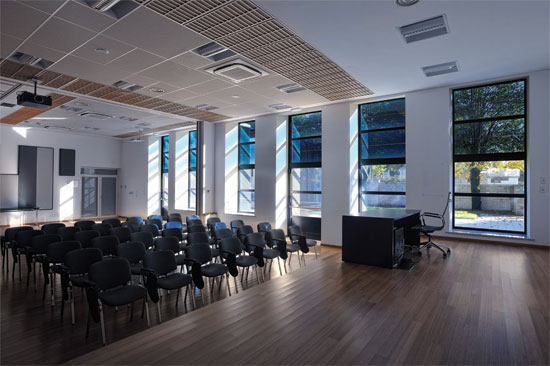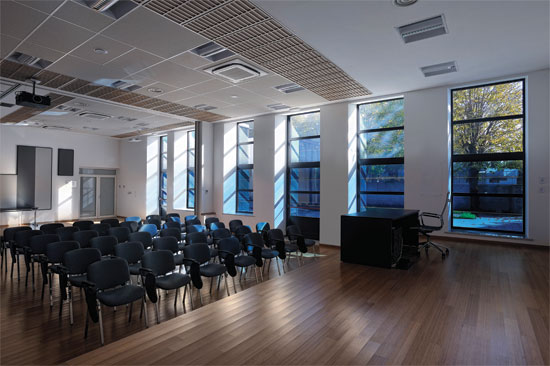Dynamic Solar Control with Electrochromic Glazing
Comfort Through Glare Control
The qualities that make EC glazing sustainable also contribute to the comfort and performance of the building's occupants. In human factors evaluations conducted by the Lawrence Berkeley National Laboratory (LBNL), people greatly preferred to be in a room with electrochromic windows versus a room with regular static glass and blinds, because of the level of comfort it brought to the space. This supports what we have already established, namely that controlling glare improves occupant comfort and productivity. But equally important, when glare is removed, occupants can see without closing blinds or shades. With static glass, the only way for an occupant to control glare is to pull the shade or blinds. Most shades are controlled manually but even in automated systems, glare often forces occupants to override the system and close them. So blinds or shades are closed when glare is present, but rarely reopened at the optimized time for energy efficiency. This unhappy situation negates the benefits of the window and decreases the effectiveness of any daylighting strategy. The penalty of glare discomfort is that electric lights get turned on that might otherwise have been kept off.
By using dynamic EC glazing, windows can be dimmed down to 2 percent VLT eliminating glare without blocking the view outdoors. By comparison, static windows in commercial buildings typically transmit around 45 percent visible light, thus the need for shading. When glare is removed, occupants can see their computer, tablet, phone, TV screens, or the view out their window without the need for closing blinds or shades.
Material Protection
Many materials are damaged by too much exposure to the sun, primarily through fading or degradation. Ultraviolet (UV) light is the primary culprit that causes fading so most glass manufacturers measure UV transmittance only. But even glass that claims 98 percent UV protection covers only the 300 – 380nm wavelength range. That still admits sizeable amounts of damaging radiation in the visible spectrum. The most advanced dynamic electrochromic glazing blocks nearly 100 percent of UV but it also blocks 97 to 98 percent of the total radiation spectrum that can cause fading damage to furniture, artwork, carpet and other materials. Controlling solar radiation eliminates the embedded costs of fading including the manufacturing, transporting, maintaining, replacing and disposing of large amounts of interior materials that are otherwise damaged.
Durability
One key measurement of true sustainability is durability. Over a long life cycle durable products save energy and resources required to manufacture, transport, maintain and dispose of products that otherwise need frequent replacement. Increasing the durability of windows means that all of these life cycle costs are reduced but the building owner will specifically see the benefits in reduced maintenance and replacements costs. When it comes to using EC glazing in the windows, the inorganic, all-ceramic structure of the electrochromic coatings provides a superior level of durability. In particular, they perform quite well against highly stressful environmental conditions, such as sunlight, UV exposure, and temperature, experienced by an exterior window product.
Based on the nature of the glass and the coatings, it would be expected that in the static condition, EC glazing would perform well in terms of durability. However, in the dynamic condition, it has also been shown to perform exceptionally well. Since the glazing is electronically switched to create the tinting, it is reasonable to ask how durable the product is when cycling through that switching. Toward that end, ASTM Test Standard E-2141-06 has been used by the National Renewable Energy Laboratory (NREL) to address this very question. NREL conducted the test which looked at the combined degraded effects of elevated temperature, solar radiation and extended electrical cycling. The test results showed that EC glass windows “… successfully survived over 100,000 cycles …equivalent to switching a window 9 times per day for 365 days per year across a 30-year lifetime.” This is an impressive testimony to the durability of the technology, particularly when compared to an average service life of approximately 7 to 10 years for interior blinds and shades.
So what happens if a pane of electrochromic glass gets broken? EC IGUs are easily replaceable. If the glass gets broken, it can be deglazed like any ordinary glass unit, and simply unplugged. A new IGU can be installed and reconnected to the low-voltage wiring, which resides in the glazing pocket.
LEED® Contributions
Electrochromic glazing conserves energy, and also provides an additional tool for sustainable daylighting design. The most advanced electrochromic glazing products can contribute to a number of potential LEED points including:
• Energy & Atmosphere Prerequisite 2 and Credit 1 – Optimize energy Performance: As we have seen the use of EC glazing has been shown to reduce energy demand in various ways including heating, cooling, and lighting energy. In preparing energy models to demonstrate these capabilities, the proper SHGC and VLT parameters will need to be input based on the optimal settings for the glazing.
• Indoor Environmental Quality Credit 6 – Controllability: Windows and skylights with EC glazing are programmable and can be set to operate individually or in zones, by single users or for multi-occupant spaces to meet group needs.
 |
Among the LEED contributions that EC glazing can make, controllability of the glazing to effect comfort is readily achievable. Photos courtesy of SAGE Electrochromics, Inc. |
• Indoor Environmental Quality Credit 7 – Thermal Comfort: EC glazing can be tinted to stop solar heat gain without blocking the view. In winter, the glazing can be kept in its high transmission state when maximum solar light and heat are desired, and the low-emissivity electrochromic coating helps keep the heat inside the building. In summer, it can reject the unwanted heat to help keep the interior cooler.
• Indoor Environmental Quality Credit 8 – Daylight & Views: The beauty of EC glazing is that the sun's energy can be controlled without blocking the view. EC glazing is always transparent, even in its darkest state, so people can always see through the glass. In an evaluation carried out by the Department of Energy, people greatly preferred to be in a room with EC glazed windows over one with static, low-e windows.
• Sustainable Sites Credit 8 – Light Pollution: When in their tinted state which can transmit as little as 3.5 percent visible light during the night, EC glazing dramati-cally reduces light trespass.
• Innovation in Design Credit 1 – Innovation in Design: The innovative nature of EC glazing is ripe for applying it in ways to qualify for this credit.
Clearly, EC glazing can play an important role in LEED certified buildings as an integral part of the larger sustainability design and strategies.










